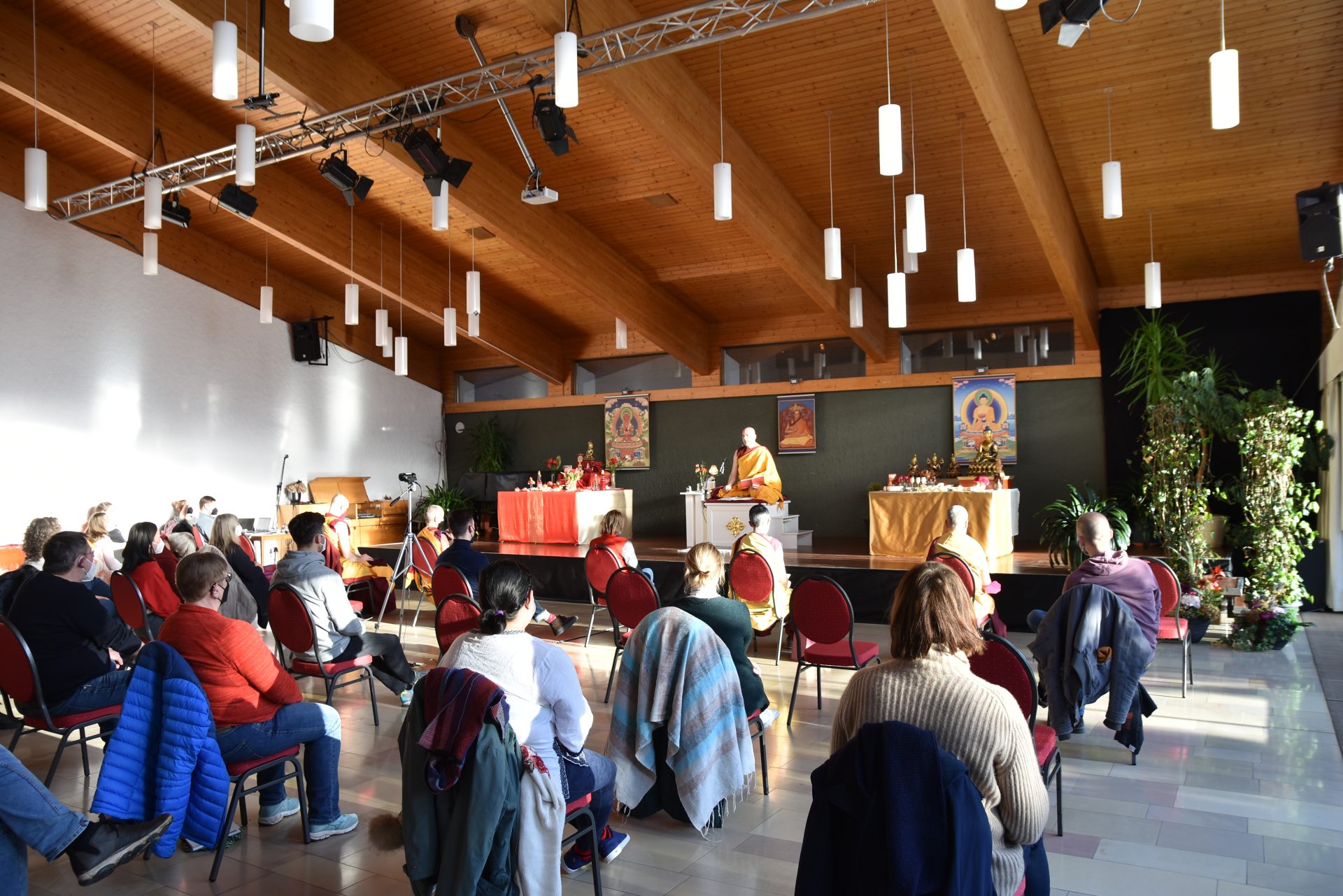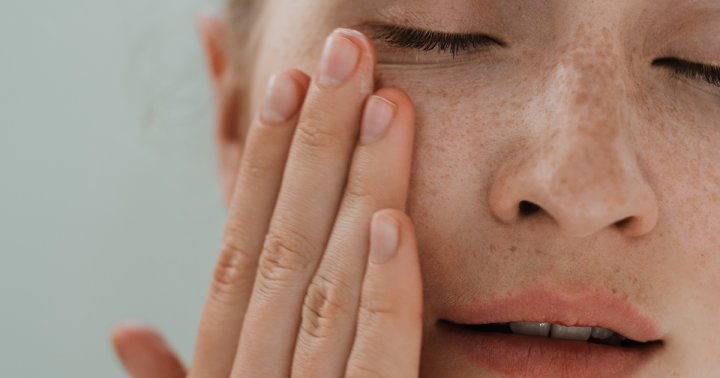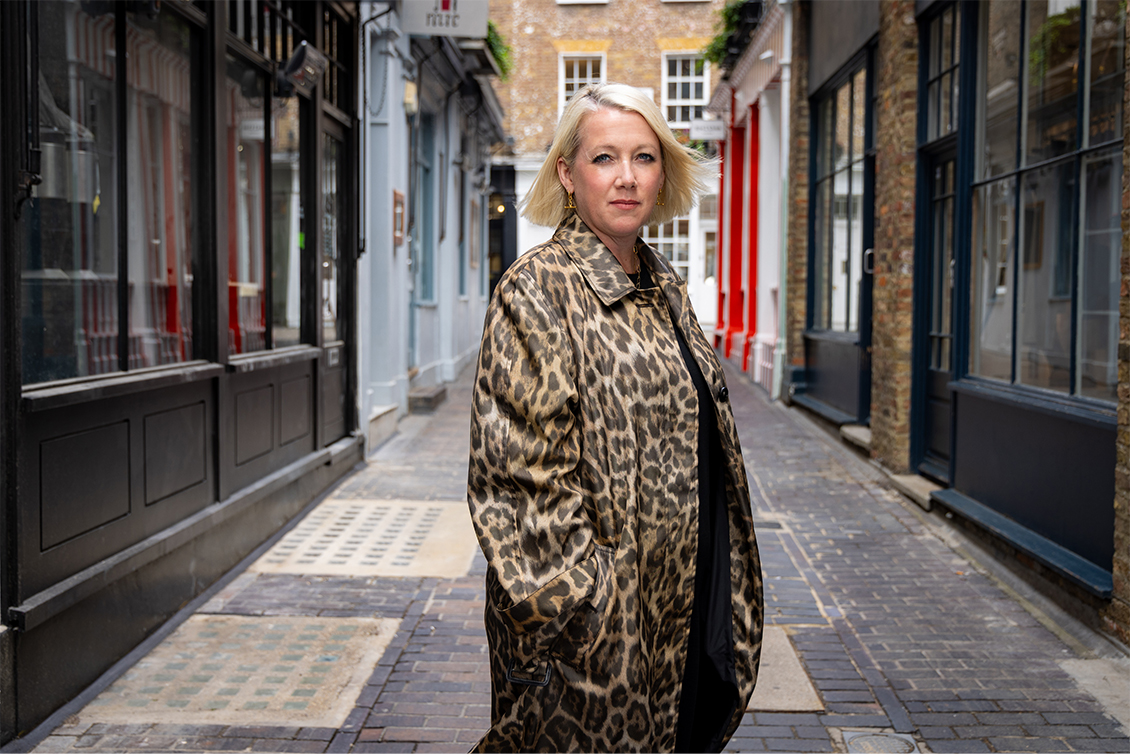On the Spectrum, On the Path
Meditation can help with navigating challenges, cultivating calm, and connecting with others. Four Buddhists with autism on how the practice has changed their lives. The post On the Spectrum, On the Path appeared first on Lions Roar.

Meditation can help with navigating challenges, cultivating calm, and connecting with others. Four Buddhists with autism on how the practice has changed their lives.

Painting by David Idell
Was the Buddha Autistic?
Louise Woodford wonders how the Buddha would be diagnosed if he were alive today.

Louise Woodford
Do you think the Buddha was perfect, not disordered, and do you think it’s absurd or shocking to suggest that he was autistic? If so, through no fault of your own, your preconceived idea of what “autistic” means could be slightly off. Autism is simply a perceived inability to behave in a way that meets the majority’s expectations. An autistic person like myself is not disordered or at any disadvantage whatsoever when it comes to progressing spiritually.
I’ve often wondered what “condition” Buddha Shakyamuni would be labeled with if he lived in the West today. From my understanding, he wasn’t one to follow the crowd (in fact he went against the expectations that were placed upon him). He avoided intimacy; found peace in solitude; found an affinity with animals; was an extraordinarily deep thinker; had high moral standards; was a lonesome child, preferring to sit by the trees rather than play with other children; moved from community to community; had no social attachment; was absolutely fixated on achieving enlightenment; and experienced the world profoundly and with unusually high sensitivity. Does that not sound familiar?
Why would I want to become ordinary?
If I were to take four long pieces of wood and place a large, flat piece of wood on top, we could label the structure “table,” since it possesses a collection of traits that meet the “tableism” criteria. I think I’m correct in saying that Buddhists generally agree that the table is a creation of mind. Take a person whose social communication differs from that of the majority, who has specific or repetitive behaviors or interests; we may agree that this person can be awarded the label “autistic.” We must, therefore, agree that like the table, an “autistic person” is also a creation of mind. Autism does not exist as an independent phenomenon, separately from the mind that created/labeled it. From a Buddhist point of view, nothing is permanent, and nothing exists independently. We speak of mere labels.
Even from a modern scientific point of view, the brain is not fixed. Thanks to neuroplasticity, our brains can change and adapt according to our experiences. Neurons can be strengthened or even created. Also consider that we are literally bundles of energy, every atom containing almost 100 percent empty space. In fact, it seems whether we search on a spiritual or scientific level, we cannot find our permanently existing selves. So, from whose perspective is “autism” a thing?
I read on the medical websites that there’s “no cure for autism; it’s a lifelong disorder.” Whoa! If nothing is permanent and the brain is plastic, that doesn’t make sense. Besides, why would I want a “cure” for my quirky personality? Why would I want to become ordinary? I’m not ill, and everything’s in good working order. Am I really considered disordered for life because I’m in a personality-type minority?
The “Autism Spectrum Disorder” label doesn’t sound very Buddhist or scientific! But despite the stigma, I suppose the “autism” label functions for now; it has helped me find my tribe. So, until the world really accepts that we’re all just wonderfully different, the label “autism” is not such a bad thing.
As environmental activist Greta Thunberg pointed out, autism can be a superpower. With the right support and in the right environment, maybe there are no limits to what autistic people can achieve. Why not enlightenment? If anyone can give the spiritual path the focus it requires, an autistic person can!
In my experience, the only autistic behaviors that cause pain in my life occur when I try to hide my difference, or try to hide in fear of judgment and expectation, or become overwhelmed by aspects of the modern society we’ve created. These are all habits created by my mind in response to experiences I’ve lived, in order to protect my ego from harm. If I strip away those negative “autistic behaviors,” I’m only left with some pretty cool and Buddhist-like traits that I’d definitely like to keep, thank you very much!
I am therefore determined to show up for life like the Buddha did—with openness and curious vulnerability, raw and unmasked. If people find me too odd or too boring, that’s okay. As one who is on the Buddhist path, being considered odd and boring from a worldly point of view is working out quite well. For now, at least, I will accept that due to my collection of unique traits, I’m labeled as “autistic” by our modern Western world, and the label functions for me, as does “table” when I need a place to set down my cup of tea. But autistic is not inherently who I am. And in my humble opinion, it’s not a disorder.
I’ve noticed how ironic it is that my tendency to seek solitude, avoid intimacy, ask too many questions, and be highly sensitive are the very traits that have made dharma groups so difficult for me to attend. Aren’t those traits that are valued in the Buddhist tradition?
For now, if you need to find me, I’ll be thinking deeply in my hermitage, residing in the forest with the animals and trees, and eating the same simple meals every day. That may only be metaphorically true, but either way, there is nothing, I repeat, nothing remotely disordered about that, and if you don’t believe me, just ask a buddha!
Comparing Causes Suffering
Pete Grella used to compare himself to nonautistic people—but not anymore.

Pete Grella
For much of my life, I would ask myself one question: Why? Why does my life seem to be different from everyone else’s? This caused me great discomfort. Undiagnosed, I had no way to understand why I was different. I would think that after I died an autopsy should be done; it would show something unusual about my brain.
Growing up, the only autism I was aware of was the nonverbal kind (now called Level 3), and I was clearly not that. At the time, the literature on autism said autistic people couldn’t read facial expressions and that they had no empathy or imagination. Yet I could read facial expressions (but not micro-expressions, it turns out). I could understand other people had feelings and their point of view, and I was imaginative. I could write songs and play Dungeons and Dragons. But I did have other things the literature referred to, such as issues with sensory stimuli. I’d also focus on small parts and see patterns in things, and I liked routines. When the internet came around in the nineties, I was able to do online tests that said I was borderline autistic. That wasn’t conclusive, though.
If I can accept all physical sensations as equal, I can stop running away from the sensations I don’t like or chasing the sensations I desire.
I was struggling with depression and loneliness and tried many things in an attempt to change my situation, including therapy and medication. Then I tried meditation and studying the dharma. This worked better than anything else.
While the techniques suggested in therapy helped a little, they were designed for people with nonautistic minds, and there are meaningful differences between the minds of autistic and nonautistic people. Autism is characterized by parts of the brain being more densely wired than in the nonautistic brain, and other parts being less densely wired. This is why those of us who are autistic can have intense sensory experiences and a mind that can hold onto something for extended periods of intense focus. Also, our emotions can be amplified or barely register. For nonautistic people, emotions usually last ninety seconds. For people on the autism spectrum, though, an emotional event can last for up to half an hour. Techniques for dealing with emotions that last for ninety seconds won’t work when emotions can last for thirty minutes.
I asked a dharma teacher if the dharma can aid in making friends. He said if you follow right speech and the precepts, you will naturally make friends. That did not match with my experience. Again, I was brought back to the question: Why am I not like other people?
I have since received an official diagnosis and have studied how nonautistic people relate to autistic people. I have discovered that autistic people have different nonverbal communication and that this creates a wall between us and the general population. Our autistic mind can strongly grasp on a singular focus, making eye contact difficult. Focusing on words and sight can be too much. We sometimes rock back and forth to alleviate the intensity of these experiences. Nonautistic people may interpret this rocking as there being something wrong with us, or that they are making us nervous. I have been told as much.
Friendships and connections are made through emotional bridges. Having emotions that are “all or nothing” (or being more matter-of-fact and less emotional in our facial expressions and gestures) makes it harder to create those emotional bridges. Studies have shown that friendship and connections are the number one factor that boosts happiness. So, if you were to design a condition to rob you of happiness, it would be autism. It inhibits the emotional bridges necessary to connect with people, and this makes us feel bad, and on top of that autism can amplify our emotions!
There are studies that show how autistic people make a bad first impression with nonautistic people, which may account for the higher rates of depression and suicide in the autistic population. Fortunately, I have found that meditation and the dharma can help. A large part of our suffering as autistic people is caused by the comparing mind and clinging to wanting things to be different. When I compare my life to the lives of nonautistic people, I can feel bad, because they have things in their lives I wish I had. The dharma teaches us that comparing mind is one of the ego’s tools; it uses comparisons with other people to construct an identity. The dharma teaches us, further, that the ego is not who we are, that we are just a consciousness experiencing this present moment. If I remind myself that this is all I am, those comparisons no longer have gravity.
Through meditation, I can learn to observe my thoughts, so when those comparing thoughts arise, I can just watch them coming and going, and recognize that is what the mind does, and I don’t have to fight it.
Mindfulness of the body has been another big help. I now recognize that emotions manifest physically in my body, and if I can observe these physical manifestations the same way I observe my thoughts, they will have less impact. I can also change my focus from my emotions to other physical sensations in my environment. When I meditate, for example, I will sometimes focus on what my feet are touching, or the air on my skin. If I can accept all physical sensations as equal, I can stop running away from the sensations I don’t like or chasing the sensations I desire.
Noted autism researcher Tony Attwood suggested that elder autistic people should pass on what they have learned to younger autistic people. I’m privileged to be able to share the dharma with other people who are autistic/neurodiverse. I hope they find as much benefit in the practice as I have.
The Joy of Low Stimulation
The zendo, with its subdued colors and deep silence, can be a refuge for people with autism, says Anlor Davin.

Anlor Davin
I am so grateful I stumbled upon Zen practice and Buddhism; before I did, my life was a complete mess.
I’m autistic but was not diagnosed until I was forty-six. During my childhood in France, I was often troubled. Rawness pervaded every aspect of my life and created tension in many directions: anxiety, restless sleep, digestion problems, sadness, frequent crying, pickiness in eating, hyper-vigilance, sensory challenges, and inappropriate silence, to name just a few of the difficulties I experienced. I tried to hide my continuous discomfort, keeping myself contained during school days only to explode easily once at home. Fortunately, my father exposed me to tennis, and this skill helped me stay afloat just enough that I managed to survive childhood.
At age twenty-three, I emigrated to the United States. For the first twelve years I lived in Chicago, where I married an American man. We divorced when our son was five, and although I was glad for the divorce, life as an undiagnosed autistic single mother was very difficult, and eventually panic attacks made me realize I had to find a new way to cope.
Being quiet with others was so unusual that it felt as if my senses were soaking up the silence like parched earth soaking up water.
Around that time a friend gave me the book Nothing Special: Living Zen by Charlotte Joko Beck. What I read about Zen made sense. I thought, why not try it?
So, I moved from Chicago to a Zen center in California. Immediately, I loved the quiet and lack of aggressiveness, rushing, and artificiality that had plagued me elsewhere. In the silence, I was finally able to relax and pay attention to my body and mind. For the first time in my life I wasn’t constantly overwhelmed by noise, lights, and other sensations. I was finally with a group of people with whom I could relax; they let me be, even when I was not understood.
When I sat zazen, which is sitting upright in silence and stillness, everyone around me was silent. Being quiet with others was so unusual that it felt as if my senses were soaking up the silence like parched earth soaking up water. Because the whole sangha practiced zazen, we all knew that words were not always necessary, that silence could be beautiful, and that less-harsh lighting was a sensory balm.
I had to leave the Zen center after six months to care for my seven-year-old son, whom I had left with his father and grandmother. Once again, I became consumed by survival, but with a new slant: every morning, on my own, I meditated. Doing the practice over and over again, both alone and with others, eventually led me to straighten myself out, physically and spiritually.
I became acquainted with what was going on inside me. Usually people distract themselves in order to push away all the unpleasantness in their lives. Yet the only way to make peace with the unpleasantness is to make space for it and embrace it.
Now, after almost twenty-five years of Zen practice, I’ve met many other autistic people who also find meditation helpful. Meditation can help neurodivergent people calm their easily excited nervous systems.
Though not all autistic people are extremely sensitive to a variety of stimuli, many really enjoy having fewer stimuli to contend with. I made up a word to describe the jarring of my senses: AGRUAR, for AGgressive, RUshed, ARtificial. Buddhist meditation happily veers away from all that is AGRUAR.
Most distractions, and by extension stimuli, are eliminated, or at the very least greatly lessened in a Zen center or meditation space. This is significant for an autistic person. Looking at a wall during meditation, rather than at moving or visually busy objects, can be a balm, and the tradition of wearing dark, subdued colors in the meditation hall is likewise soothing. Instead of words, bells and other instruments are used to signal the start and end of a meditation period, and various gestures are used to communicate, such as bowing to one another in greeting. Very little language is actually needed, and in the silence, it becomes possible to whisper to one another the necessary practical matters.
For people with autism, the level of expense required to start a meditation practice is an important consideration, too. Most autistic people have very little money, and I am no exception, so I’m very grateful for all the scholarship support I’ve received, which has made practice in my various sanghas possible. While eventually it’s necessary to practice with others, one advantage of meditation is that a person can start practicing it alone at home, with no expense required.
As an autistic person, I often feel that I’m in a minority and a bit of an outsider, and that’s why I started, with my autistic partner’s help, the sangha we named Autsit (.net). This sangha is primarily composed of autistic people, though all neurodivergent people and allies (friends of autistic people) are also welcome.
Once again, I am so grateful I stumbled upon Zen.
The Man in the Mirror
“Meditation allowed me to become self-aware,” says Joe DaRocha. “It introduced me to myself.”

Joe DaRocha
What was life like for me before I encountered Buddhism? Chaotic.
I was living a life of persistent confusion and frustration. There was no sense of psychological stability. I had this very narrow vision of life, which was completely self-destructive, and this routinely emerged in my relationships with people. Any rigidly defined relationship (teacher–student, employer–employee) worked well, but social or intimate relationships were disastrous. I simply could not sustain a functional relationship for long. It seemed like I would be repeating my mistakes indefinitely, and this left me feeling completely defeated.
But I’d always had a fascination with Buddhism. When I was twelve and thirteen years old, I watched reruns of the Kung Fu television series, which ran from 1972 to 1975, and I was mesmerized by it. The main character, Kwai Chang, was raised in China and found himself in the United States, a stranger in a strange land. Although he had the same challenges as other people, his attitude and demeanor were completely different. In every episode, I’d see him successfully manage some difficulty and think, “Wow, I wish I could do that!” That was my first exposure to the power of meditation.
Deciding I had to make a change in my life, I started to meditate, and soon it became clear that the practice was a way of discovering who I was. I’d tried a variety of Western approaches to managing my mental health, and even though they did help, there was always something missing. Fundamentally, I didn’t know this Joe DaRocha person. Meditation and Buddhism allowed me to become self-aware. Meditation introduced me to myself. I began to see myself differently. The biggest revelation I had was that I was playing an active part in my own self-destruction.
In so many ways, Buddhism fits my personality.
Yes, there were challenges and obstacles beyond my control, but I was right there making sure they got worse and that I would remain frightened and defensive all the time. I began to see that I was the author of my own self-annihilation. The enemy was in the mirror.
It was a complete yet gradual process of relearning until eventually my entire perspective on things had changed and subsequently, so had my reactions. For example, I used to be afraid of snakes, absolutely terrified. Then several years after I started meditating, I decided on one occasion to meditate in my backyard. Just before my meditation ended I heard this soft rustling sound, and when I opened my eyes there was a milk snake slithering by, about three feet in front of me.
The first thought that entered my mind was This is his world, too. It was the recognition that the snake belonged there, just like I did. I had absolutely no fear, and I could feel myself smiling. It was an amazing experience; in the language of Zen, it was satori—a sudden moment of awakening, an ability to see the truth clearly. That experience would never have happened without my meditation practice.
In so many ways, Buddhism fits my personality. I’m a fairly solitary person, I rarely socialize, and I don’t like groups. But in the Buddhist tradition I can practice a lot on my own. I have guidance, instruction, and attention from teachers, but in the end, it’s entirely up to me.
No one is going to give me self-awareness; no one is going to tell me how to become liberated. It’s just, Here is the philosophy, here is the practice. Go figure it out. See what you find. I really like that.
In navigating my mental health, I’m skeptical of any method of external spiritual solutions. I have no faith that the answers to my existential and spiritual questions lie “out there.” I’m convinced that the answer has to come from within. For me it’s simple logic: if my spiritual/mental health questions are being generated by the mind, then it’s in “the mind” where I can find the answers.
A real challenge many autistic people face is that they’re locked into their own view. The thinking is narrow; the world is either-or with little or no room for another perspective. I understand how it feels to live in that world. It’s a limiting existence. It restricts the options and solutions that one can access to make things better. The experience of being restricted due to my autism was like living in a hut on an island. Meditation hasn’t allowed me to leave the island—I can’t “cure” my autism—but it has allowed me to step outside the hut and explore the island itself.
Therapy, counseling—it all helped. Yet it was still someone on the outside trying to help me see the world a little differently, whereas in Buddhism, I can experience the world myself. I can see myself in it and navigate through it, not just from a perspective that I’ve learned but from a perspective that I’m living.
I would also add that medication made a big difference in my life. I take medication regularly and would always recommend seeing a doctor about a mental health issue first. I’d never say that Buddhism and meditation will absolutely improve the lives of all Level 1 autistic people; that’s just too extreme of an assertion. But it definitely will help some people.
Buddhism and the practice changed my life, gave me things I thought I would never have. It gave me clarity. It gave me a spiritual practice, a set of teachings, and a community.
One time at work I heard that there was another staff person who was a Buddhist, and I went out of my way to meet her. I remember approaching her, introducing myself, and asking her if she was a Buddhist. She said yes, and there was this instant understanding. It was like traveling in a foreign land, where you don’t know the language, the culture, or the people, and then suddenly you run into someone from your hometown.
She was a Tibetan Buddhist, and I am a Zen Buddhist. When we talked, we challenged each other about our different practices. The conversations were fun, educational, and without any hint of discomfort.
Once I was questioning her on prostrations (a devotional practice where you lie down and touch your head to the floor repeatedly). This was a practice she did but I did not, and the more she explained it, the more questions I had. Then knowing that I would likely not get what the benefit of this practice was, she shook her head slightly and with this wonderful smile, said, “Oh Joe, you’re such a Zen Buddhist!” It was one of the nicest things anyone has ever said to me.

 UsenB
UsenB 






























